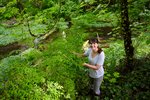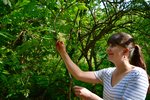

The first time Eve Hanlin dug her fingers into rich soil, she was mesmerized by the possibilities of teaching herself and others how to grow and sustain a healthier lifestyle.
The 21-year-old “professional plant nerd,” from Battle Ground, read every book she could find on gardening, experimented with growing food and harvested wild edible plants in her own backyard. But there was still one question that left her perplexed… what to do with those pesky weeds?
“At first, I was just like everyone. I though weeds were weeds,” Hanlin said. “As I learned to identify the weeds I was pulling out, I discovered that more and more of them were edible. I started to get daring by tasting them and cooking with them. My nerdom grew from there.”
Hanlin’s gardening adventure kicked into high gear after completing a Clark County Master Gardener training program through Washington State University in 2011. She gained valuable experience by volunteering at local plant fairs and farmers markets. She also leads workshops at Columbia Springs, in Vancouver, and Gail’s Learning Center, in Brush Prairie, teaching adults and children how to turn weeds into tasty ingredients.
“People are afraid to eat the weeds. There’s a stigma where they say, ‘ew! Eating weeds, no way!’ Hanlin admits.
“Most of these things are on the grassy side, at first. The benefit comes when you cook with these flavors. You get these really tangy lemon greens or these spicy mustard greens,” she counters. “If everyone started incorporating these weeds into their diet, we would all be healthier. We would all have access to fresh, organic produce in our own backyard.”
What people fear about eating greens, mushrooms and berries out in the wild is consuming something that’s poisonous, especially when edible and harmful plants grow right next to each other. Hanlin said there are several resource books out there. One of her favorites is “The Front Yard Forager,” by Melany Vorass Herrera.
“Always learn from three sources,” Hanlin suggests. “You can identify a plant from one book, from another book, from a friend or from a website. By the time you get to three sources, you can feel confident whether that plant is edible or not.”
Hanlin’s “Intro to Urban Foraging” workshop provides a visual aid for first timers. She spends the first hour giving instructions before facilitating her students outside and allowing them to explore.
“You get to spend time looking at plants and interacting with nature. That’s the best way to learn,” she said. “You get to see the plant, you get to touch it, look at the underside of the leaf, look at the shape and taste. Take a little nibble, if you so choose.”
Although adults are never too old to start foraging, Hanlin also hopes to reach the younger generation.
“You want to teach them how to interact and enjoy being in nature and how to protect it,” she said. “And then, they grow up having an appreciation for it as well.”
Hanlin’s parents appreciate her fascination with foraging. Her father grew up working on a dairy farm in Pennsylvania. When she moved cross country to the Pacific Northwest 11 years ago, Hanlin could finally harness her dreams in the untouched soil.
“We have a little patch of land in Battle Ground, which was our dream,” Hanlin said. “A small homestead where we could stir things up.”
If Hanlin is the chef, the meal is sure to be an adventure for your taste buds.
“We eat weird things all the time,” she said.